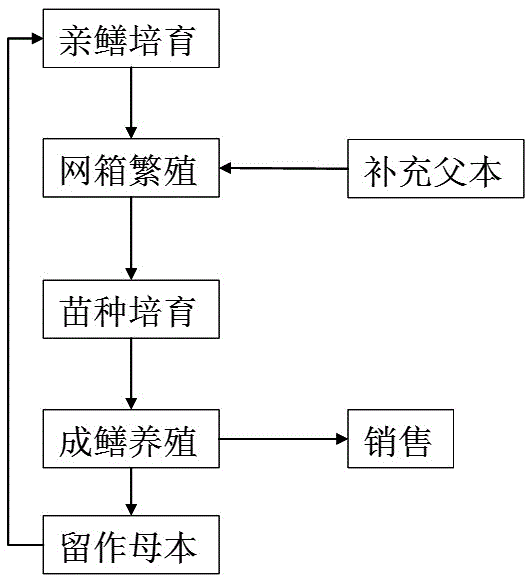Finless eel self-reproducing, self-breeding and self-cultivating mode
A technology of self-propagation of rice field eels, applied in the field of ecological breeding of rice field eels and seedlings in cages, can solve the problems that the amount of wild seed resources is susceptible to climate and environmental changes, the decline in the efficiency of rice field eels breeding, and the difficulty in ensuring quantity and quality. It solves the asynchronous development of gonads, is conducive to centralized cultivation, and improves the effect of stocking growth rate
- Summary
- Abstract
- Description
- Claims
- Application Information
AI Technical Summary
Problems solved by technology
Method used
Image
Examples
Embodiment 1
[0039] This example takes 400 breeding cages as an example for breeding.
[0040] (1) Ecological imitation breeding of eels in cages
[0041] (1.1) Breeding and selection of parent eels
[0042] The parent eels used for breeding for the first time need to be artificially cultivated for one year, that is, seedlings are put in at the beginning of July of that year, and after artificial breeding from July to October, they can be used as breeding parents in the next year. The specific training plan is as follows:
[0043] ⅰ delivery. In order to meet the needs of 400 breeding cages for feeding parent eels, a total of 2,000 female eels and 1,000 male eels need to be put in (due to certain losses during the breeding process, the number is slightly greater than the actual demand for breeding parents)
[0044] At the beginning of July, when there are more than 3 consecutive days of sunny and high temperature weather, the wild eel seedlings are placed in the cages for cultivating ee...
PUM
| Property | Measurement | Unit |
|---|---|---|
| Thickness | aaaaa | aaaaa |
| Thickness | aaaaa | aaaaa |
Abstract
Description
Claims
Application Information
 Login to View More
Login to View More - R&D
- Intellectual Property
- Life Sciences
- Materials
- Tech Scout
- Unparalleled Data Quality
- Higher Quality Content
- 60% Fewer Hallucinations
Browse by: Latest US Patents, China's latest patents, Technical Efficacy Thesaurus, Application Domain, Technology Topic, Popular Technical Reports.
© 2025 PatSnap. All rights reserved.Legal|Privacy policy|Modern Slavery Act Transparency Statement|Sitemap|About US| Contact US: help@patsnap.com


